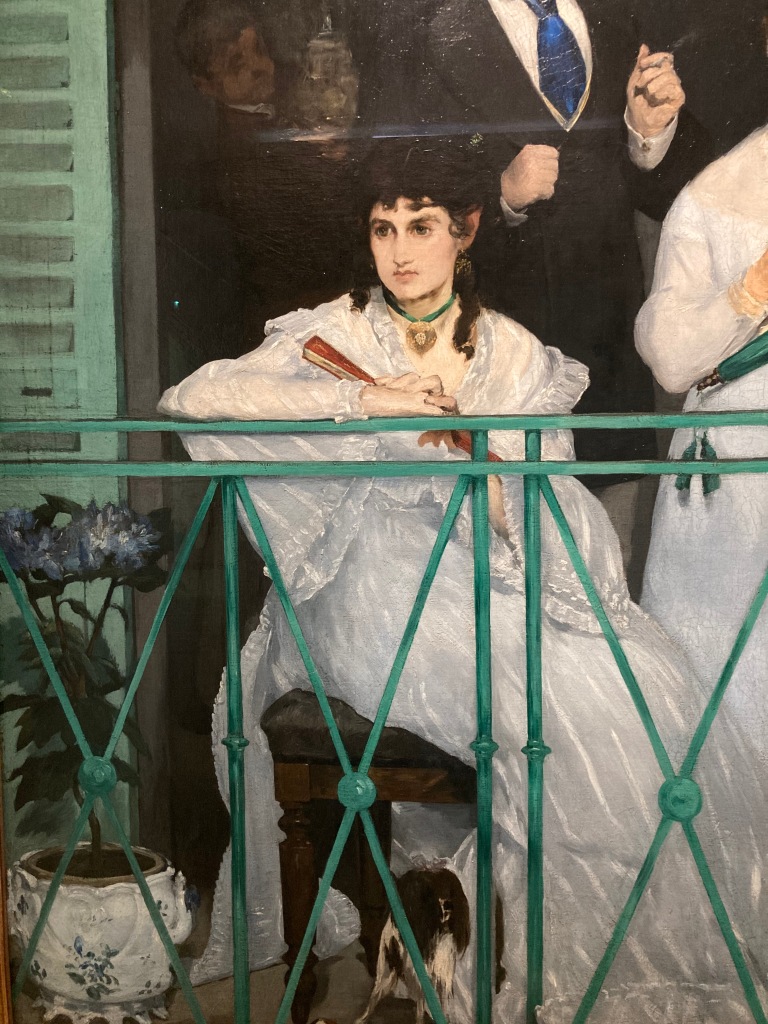Today I was dreaming about having a balcony in Paris. Not necessarily a huge one. A small one would be fine for me. One like Le Balcon (The Balcony) painted by Edouard Manet in 1868/1869 would be perfect. I love that picture. It really is one of my favorite paintings ever so I decided to write for you its history or, at least, a part of it.
One day, strolling along a street in Paris, Manet noticed two women sitting on a balcony, the interior opening up behind them. This image reminded him of the Majas at the balcony by Francisco Goya and compelled him to paint his own Parisian version of the Spanish painting. Inspired, he soon started to work on it and posed four of his friends on his mother’s balcony in Rue de Saint-Petesbourg.
We know all of them: the woman sitting on the left hand side of the balcony is the painter Berthe Morisot; the other woman is the violinist Fanny Claus, a close friend of his wife Suzanne; the standing man is the painter Jean Baptiste Antoine Guillemet who actually complained about the endless sitting required by the Manet. If you look carefully, in the interior’s background, you can also see the young Leon Leenhoff, the artist’s son.
At the first sight the composition seems very simple, immediate, quite realistic but in reality Manet studied every single detail of it. He made several preparatory studies, individual portraits of his friends (an unfinished portrait of Fanny Claus is now in the Ashmolean Museum) and had them modelling for him a lot of times – according to Guillemet at least 15 times (and he also remarked that Fanny Claus still looked “atrocious”). Truth is Manet worked on Le Balcon like a crazy man, one minute thinking that it was a masterpiece, the next quite the opposite. When the picture was displayed at the Salon in 1869 Berthe Morisot told to her sister Edma: “I’ve never seen anyone in such a state, one minute he was laughing, the next insisting his picture was dreadful; in the next breath, sure it would be a huge success”. She also said: “I am more strange than ugly, it seems that people asking about it have used the words femme fatale to describe me” (Je suis plus étrange que laide; il paraît que l’épithète de femme fatale a circulé parmi les curieux).
The last phrase is enlightening: the audience (and sometimes his friends) could not really understand Manet work, starting with its style characterised by strong color’s contrast and lack of “definition” and finishing with his strange people’s “arrangement” in which Berthe’s figure immediately attracts all the attention. Even if she is not alone and she is not in the center of the composition, we have the feeling that Le Balcon is mainly a portrait of her. Contrasting with the barely sketched faces of Guillemet and Claus her face is detailed. Her gaze, her inner thoughts reflected on her face, her mystery are the first things we notice when we look at the painting for the first time. All we want to know is why she is looking in the other direction. Manet did capture the tension between her and the other woman and disconnected all the characters who actually ignore each other. His friends are treated and painted as motionless part of a strange, human still life.
Critics, as usual, did not appreciate Manet’s art. The aggressive colours – especially the acid green of the balcony and the shutters framing the composition – caused to Manet’s work to be described as “coarsed art” at “the level of a house painter” by Albert Wolff, Manet’s nemesis.
Manet kept Le Balcon until his death. It is not clear to me if he never found a buyer or if decided to keep it but it stayed in his studio until 1883. It was then bought by the impressionist painter Gustave Caillebotte who eventually left it to the French State with all his collection in 1894.
If you want to admire Le Balcon today, you can visit the Musee d’Orsay after lockdown or you can follow this link and enjoy it on Google Arts&Culture



